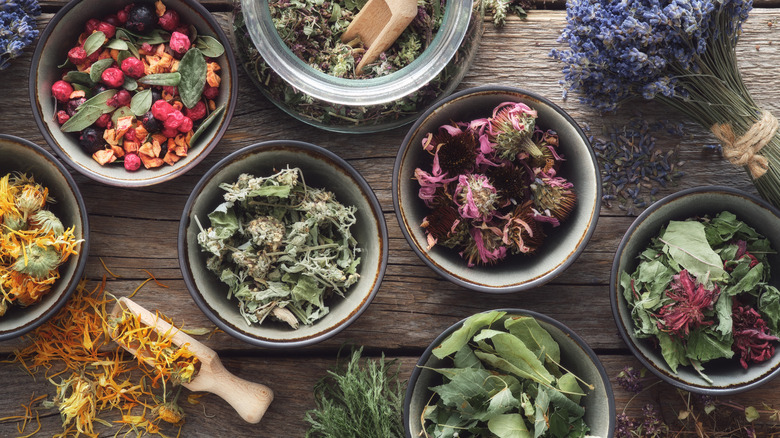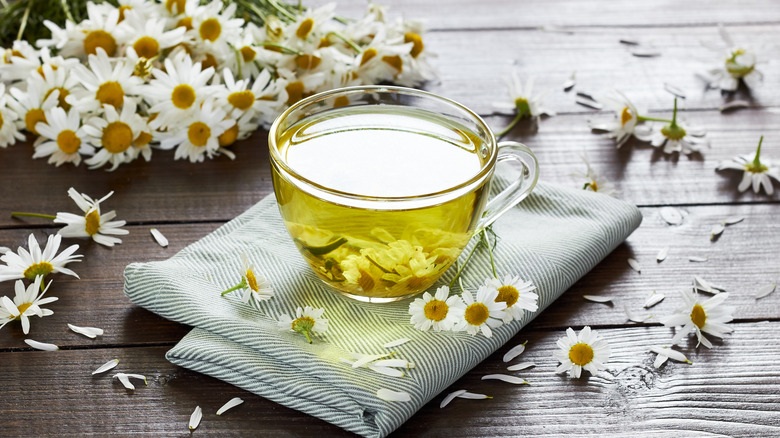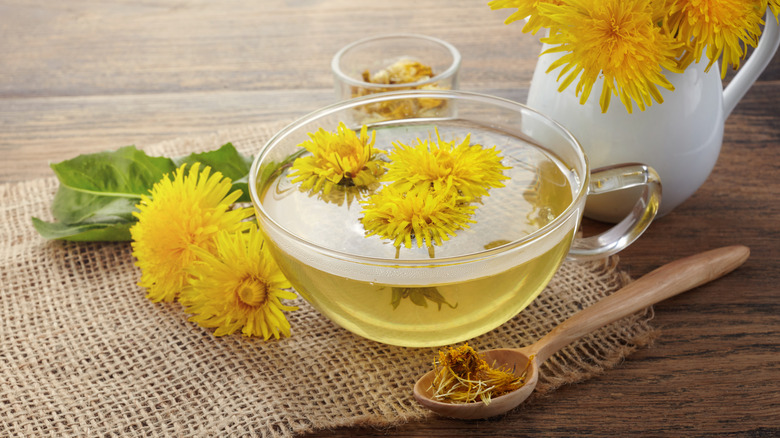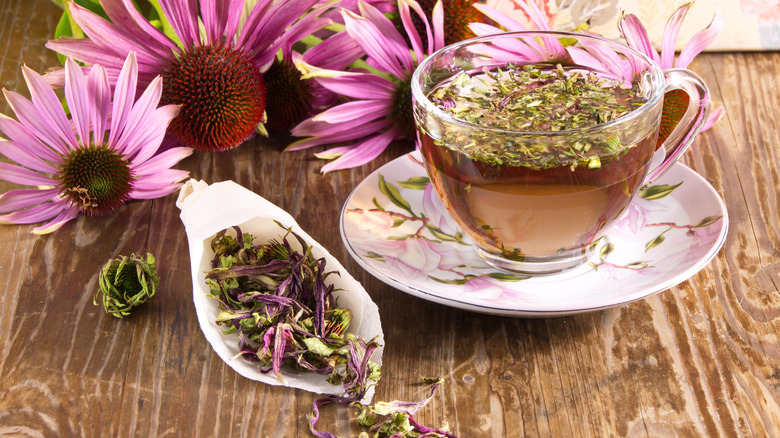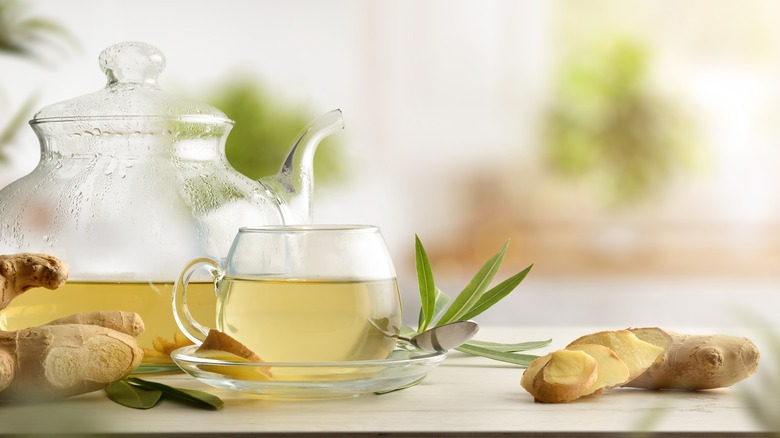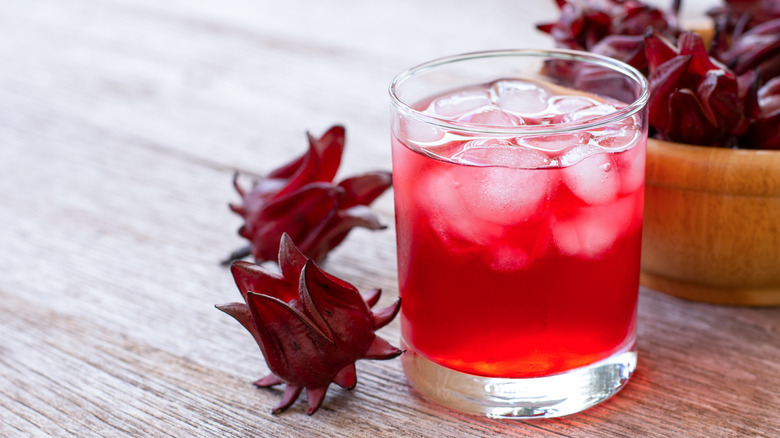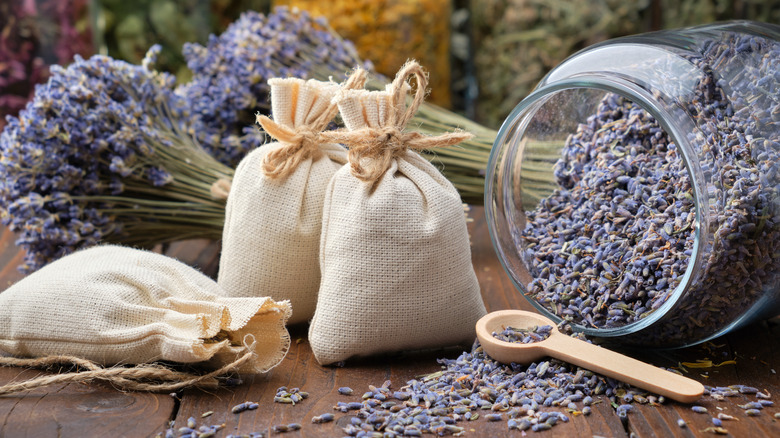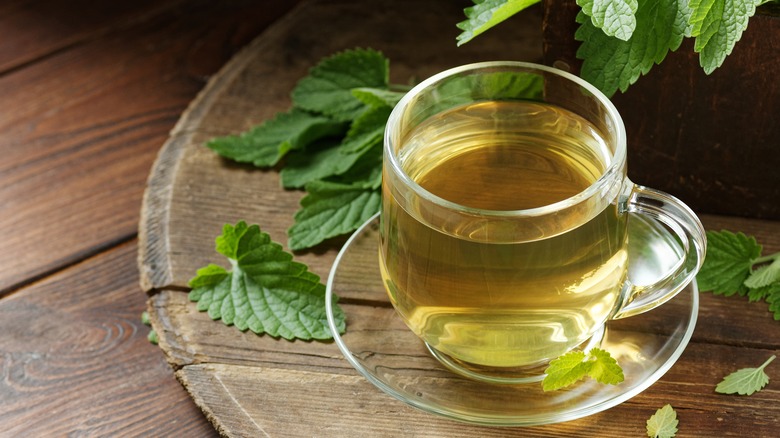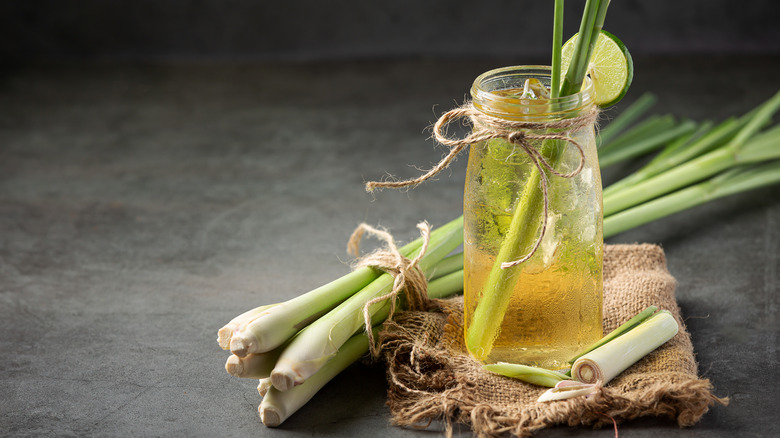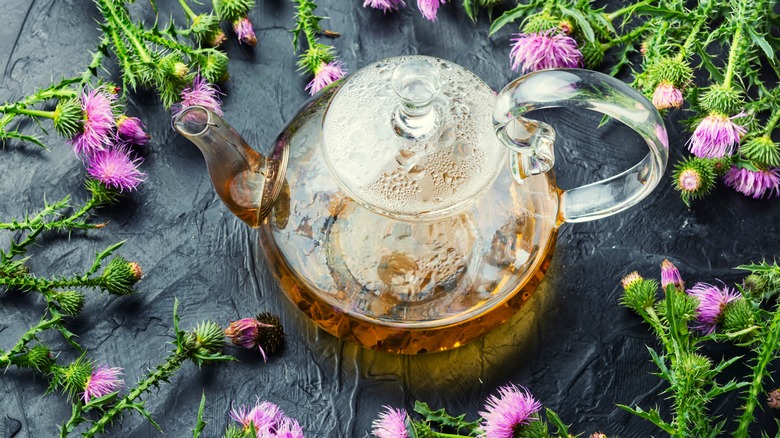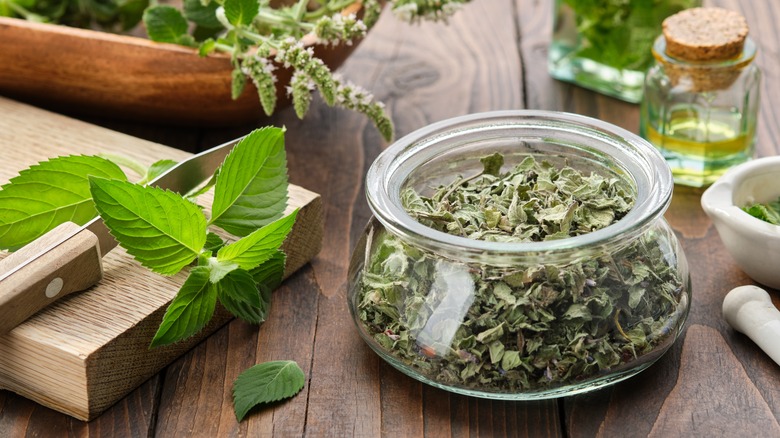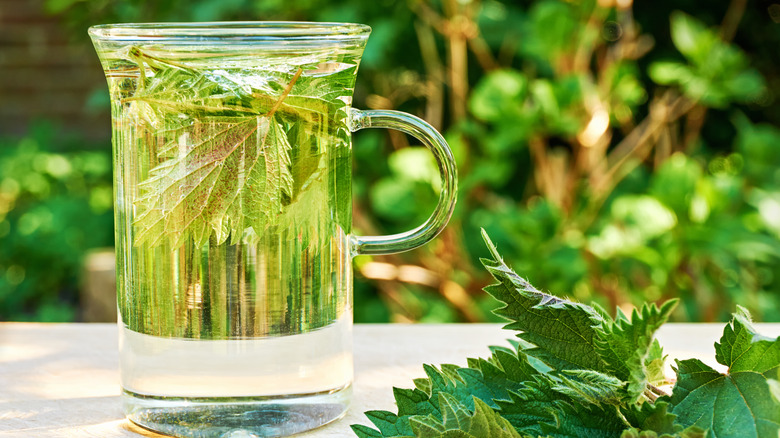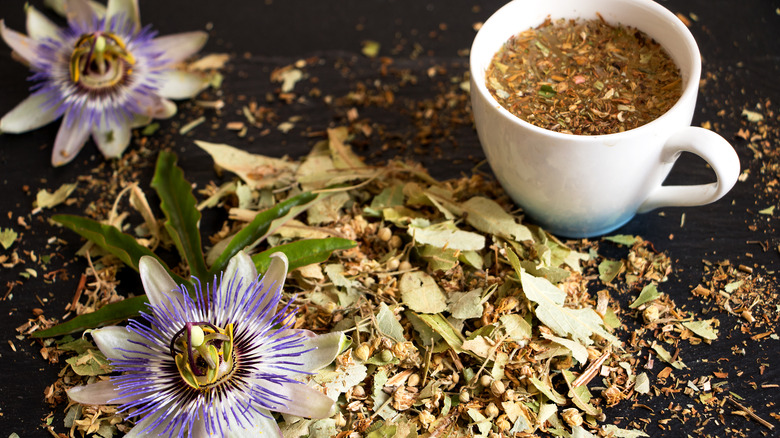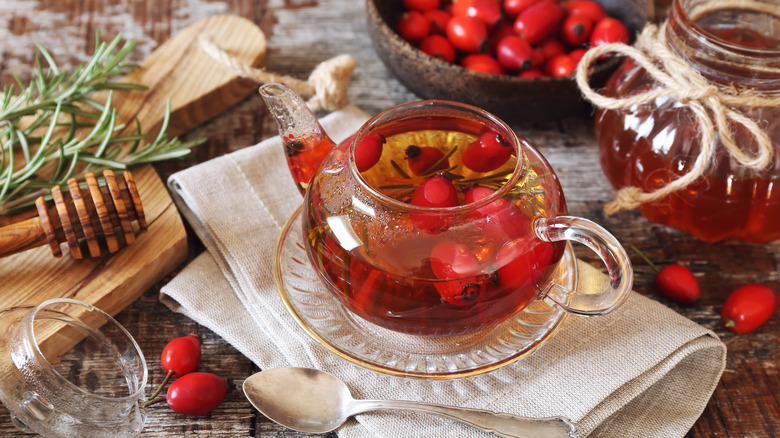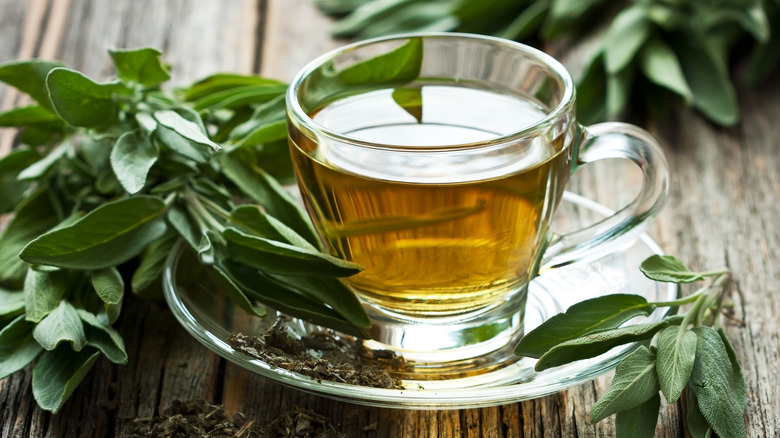15 Plants You Can Grow That Are Great For Homemade Herbal Tea
A garden can be much more than a display of showy blossoms and country fair prize-winning squash. A garden can be a veritable wellspring of nutritious and delicious herbs and edible flowers, many of which can be harvested and used to make homemade herbal tea.
Homemade teas have the power to provide an array of medicinal benefits. They can also simply refresh you on a hot day or calm your nerves and warm you up on a cold day. Chef and Saveur blogger Sylvia Fountaine adds that making blends from your own garden guarantees the freshest ingredients, which will yield the best flavor and highest nutritional content.
Often, the flowers or leaves of one plant will make a worthy tea on their own, but you can also try out different combinations. To craft the perfect blend, the key is experimentation. Take notes and taste test as you go, and, of course, enjoy the process. Fountaine reminds us that, while the teas themselves often calm anxiety and bring on a sense of focus and relaxation, so does the art of making them.
Herbal tea blends can be steeped in diffusers or homemade tea bags. FTD by Design says homemade tea bags are easy to construct out of coffee filters. All you really need from there is a pair of scissors, some string, and a stapler. Cut, fold, fill, secure, and steep. Then sit back and sip slowly.
1. Chamomile
German and Roman are the two primary types of chamomile. According to Growing in the Garden, German chamomile (Matricaria chamomilla) is the go-to for tea. Simple Seasonal suggests making your tea with fresh instead of dried flowers for a sweeter, fruitier flavor profile. Pull the blossoms away from the stems and steep them in a tea infuser with hot water. Chamomile makes a soothing tea good for relieving an upset stomach.
Bloom Season: Summer
USDA Growing Zone: 5 to 8
Growing Conditions: Full sun to partial shade
Soil Type: Light and sandy
Size: Up to 3 feet tall
2. Dandelion
That pesky weed landscapers are always trying to get rid of is actually very good for the body. Per Traditional Medicinals, bitter-tasting dandelion tea (Taraxacum officinale) is excellent for detoxification and proper digestion. Dandelions are also high in vitamins and minerals. MasterClass explains that the edible flowers are great for salads, but it's the roots that make the tea. Because of their weed-like tendencies, dandelions are hard to kill and can grow in almost any condition.
Bloom Season: Spring
USDA Growing Zone: 3 to 9
Growing Conditions: Various
Soil Type: Various
Size: 6 to 18 inches tall
3. Echinacea
Echinacea purpurea, the eastern purple coneflower, has been considered a beneficial medicinal plant for centuries and modern-day research proves its efficacy. The plant's main benefit is improved immune system function. It's also believed to reduce inflammation, calm anxiety, and treat skin conditions such as eczema. The flowers contain high levels of antioxidants. Per Sencha Tea Bar, pair the pine-like flavor of echinacea tea with honey and lemon.
Bloom Season: Summer
USDA Growing Zone: 3 to 8
Growing Conditions: Full sun to partial shade
Soil Type: Well-draining
Size: Up to 5 feet tall and 2 feet wide
4. Ginger
Ginger plants (Zingiber officinale) yield an edible rhizome that grows horizontally underground. Peel and slice the freshly harvested rhizome and leave the pieces to steep in hot water for a refreshing tea. Known worldwide as a digestive aid, ginger improves blood circulation, alleviates nausea, reduces inflammation, and more. Culinary ginger and its medicinal uses have a long history stretching back thousands of years to ancient China and India.
Bloom Season: Insignificant flowers in fall
USDA Growing Zone: 8 to 12
Growing Conditions: Full sun
Soil Type: Nutrient dense
Size: Aboveground shoots can be 3 to 4 feet tall
5. Hibiscus
Hibiscus tea comes from the flowers of the Hibiscus sabdariffa variety. Called roselles, these blooms are smaller and less showy than their cousins, the traditional ornamental hibiscus flowers associated with tropical landscapes, explains Gardening Solutions from the University of Florida. Roselles are also called Florida cranberry because they can be used in place of the fruit for cranberry sauce. These plants can be grown by seed or propagated by cuttings. They require high temperatures and heavy watering.
Bloom Season: Fall
USDA Growing Zone: 9 to 10
Growing Conditions: Full sun
Soil Type: Well-draining
Size: Up to 7 feet tall
6. Lavender
There are many varieties of lavender, however per Gardening Design, English lavender (Lavandula angustifolia) is most commonly used for culinary purposes because it contains less camphor than the others. Used for aromatherapy or as a tea, the scent of lavender is calming and promotes restful sleep. The multi-faceted perennial is also one of the best plants to include in your garden if you're a Gemini.
Bloom Season: Summer into fall
USDA Growing Zone: 5 to 8
Growing Conditions: Full sun
Soil Type: Sandy, gritty, well-draining
Size: 2 to 3 feet tall and 2 to 4 feet wide
7. Lemon balm
As is expected by its name, lemon balm (Melissa officinalis) brings a bright lemon scent and light citrus flavor to tea. Plants for a Future notes that lemon balm is the plant that produces citronella, the essential oil known for calming the nervous system. In the garden, you can expect it to be a drought-tolerant, self-seeder that may prove difficult to stop from growing.
Bloom Season: Summer into fall
USDA Growing Zone: 4 to 8
Growing Conditions: Full sun to partial shade
Soil Type: Sandy or loamy, well-draining
Size: Up to 30 inches tall and 16 inches wide
8. Lemongrass
If you've got lemon balm already planted you may wonder why you'd add lemongrass (Cymbopogon citratus) to the mix. The funny difference, as explained by tea makers at The Whistling Kettle, is that lemon balm brings a strong lemon scent while lemongrass brings the intense flavor. The University of Wisconsin-Madison Division of Horticulture labels lemongrass a dense, clumping tropical grass with few pest-related issues.
Bloom Season: Ornamental grass, does not flower
USDA Growing Zone: 10 to 11
Growing Conditions: Full sun
Soil Type: Rich loam, well-draining
Size: Up to 3 feet tall and 6 feet wide
9. Milk thistle
Milk thistle (Silybum marianum) gets its name from the milky sap that oozes out of its stems when cut and its thistle-like purple flowers, per Missouri Botanical Garden. The medicinal properties of this plant are primarily related to liver detoxification. Medical News Today also notes that it's good for fostering healthy skin, lowering cholesterol, and reducing insulin resistance, an important benefit for those managing diabetes.
Bloom Season: Summer
USDA Growing Zone: 5 to 10
Growing Conditions: Full sun
Soil Type: Moderately fertile, well-draining
Size: Up to 5 feet tall and 4 feet wide
10. Mint
Per the Farmers' Almanac, mint is known as a creeper plant and it's so easy to grow you'll spend more time managing overgrowth than nursing sick plants back to health. For your own health, mint goes the distance, providing headache relief and digestion support, in addition to a tea bursting with refreshing flavor. The most common varieties of mint grown in an herb garden are peppermint (Mentha piperita) and spearmint (Mentha spicata).
Bloom Season: Summer and fall
USDA Growing Zone: 3 to 8
Growing Conditions: Full sun to partial shade
Soil Type: Moist, well-draining
Size: 1 to 2 feet tall
11. Nettle
The common nettle plant (Urtica dioica) is also called the stinging nettle because its leaves are covered in stinging hairs that cause skin irritation, notes Plants for a Future. Though it causes pain topically, nettle tea has long been used internally to help with everything from heart problems to gut health to arthritis pain (via Healthshots). Nettle tea should not be consumed during pregnancy.
Bloom Season: Spring, summer, and fall
USDA Growing Zone: 3 to 10
Growing Conditions: Full sun to partial shade
Soil Type: Sand, loam, or clay
Size: 4 feet tall and 3 feet wide
12. Passion flower
Passion flowers (Passiflora incarnata) are so good at reducing anxiety and promoting sleep that Healthline suggests a nightly mug of their tea. It has also been shown to reduce the severity of hot flashes associated with menopause. Per NC State Extension Gardener Plant Toolbox, this vining plant can be kept as a bush by pinching back the vines. Do this at the end of its first season.
Bloom Season: Spring and summer
USDA Growing Zone: 5 to 9
Growing Conditions: Full sun to partial shade
Soil Type: Clay, loam, or sand
Size: Trailing vine with 1- to 3-inch flowers
13. Rose hip
Rose hip, or rosehip, tea can be made from the fruit of any rose plant (Rosa spp.). It will have a distinctly tangy and floral flavor profile even though the flower petals are not generally used, notes Sencha Tea Bar. Growing specifications for rose plants will vary depending on species and cultivar. The conditions below are generally suitable for most varieties, according to the Farmers' Almanac.
Bloom Season: Spring, summer, fall
USDA Growing Zone: Varies
Growing Conditions: Full sun
Soil Type: Slightly acidic to neutral pH
Size: Depends on variety; dwarf, bush, climbing
14. Sage
The sage plant (Salvia officinalis) is a popular herb and hardy perennial that requires extensive sun exposure and well-draining soil, notes the Farmers' Almanac. Sage is a member of the mint family, though it tastes nothing like it. Healthline reports that sage is beneficial for its high antioxidant and anti-inflammatory properties. It can also be used to heal wounds. Good companion plants for sage include cabbage, carrots, and rosemary.
Bloom Season: Summer
USDA Growing Zone: 4 to 8
Growing Conditions: Full sun
Soil Type: Slightly acidic to neutral pH
Size: 12 to 30 inches tall
15. Valerian
Used since the second century A.D. to cure insomnia, valerian (Valeriana officinalis) is believed to reduce anxiety by increasing GABA levels in the brain (via Mount Sinai). It has also been shown to relieve cramps and irritable bowel syndrome. Valerian is easy to grow to the point of potentially becoming a weed.
Bloom Season: Late spring or early summer
USDA Growing Zone: 4 to 8
Growing Conditions: Full sun (Will not grow in shade)
Soil Type: Prefers moist soil but tolerates a wide variety including sand, loam, and clay
Size: Up to 5 feet tall and 3 feet wide
